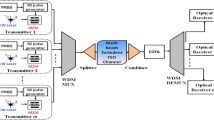Abstract
To reduce the effect of atmospheric turbulence and stabilize the optical link in free-space optical (FSO) communications, we have proposed to use an optical duplicate system (ODS) as a multi-beam generator. In this paper, a transmitter adopting the ODS is designed and constructed for the experiment. Moreover, the experiment is conducted to transmit multi-beam generated by the ODS between two points on the ground at a distance of about 450 m. In this experiment, it is found that when the number of multi-beam generated by the ODS is increased from one to two, the width of the probability density distribution of the light intensity calculated from the movies captured by the receiver becomes narrower, and the variation of the light intensity becomes smaller. It is experimentally demonstrated that the effect of atmospheric turbulence can be reduced by the ODS. These results indicate that the ODS will make a significant contribution to the stabilization of optical link in FSO communications.






Similar content being viewed by others
References
Toyoshima, M.: Trends in satellite communications and the role of optical free-space communications [invited]. J. Opt. Netw. 4, 300–311 (2005). https://doi.org/10.1364/JON.4.000300
Majumdar, A.K.: Free-space optical (FSO) platforms: unmanned aerial vehicle (UAV) and mobile. In: Majumdar, A.K. (ed.) Advanced Free Space Optics (FSO) A Systems Approach, pp. 203–225. Springer, New York (2014). https://doi.org/10.1007/978-1-4939-0918-6_6
Kaushal, H., Jain, V.K., Kar, S.: Overview of wireless optical communication systems. In: Kaushal, H., Jain, V.K., Kar, S. (eds.) Free Space Optical Communication, pp. 1–39. Springer, New Delhi (2017). https://doi.org/10.1007/978-81-322-3691-7_1
Kaymak, Y., Rojas-Cessa, R., Feng, J., Ansari, N., Zhou, M., Zhang, T.: A survey on acquisition, tracking, and pointing mechanisms for mobile free-space optical communications. IEEE Commun. Surv. Tutor. 20, 1104–1123 (2018). https://doi.org/10.1109/COMST.2018.2804323
Son, I.K., Mao, S.: A survey of free space optical networks. Digit. Commun. Netw. 3, 67–77 (2017). https://doi.org/10.1016/j.dcan.2016.11.002
Nakayama, T., Takayama, Y., Fujikawa, C., Watanabe, E., Kodate, K.: Compact optical duplicate system for satellite-ground laser communications: application of averaging effects. Opt. Rev. 21, 659–667 (2014). https://doi.org/10.1007/s10043-014-0106-x
Nakayama, T., Takayama, Y., Fujikawa, C., Kodate, K.: Controlling laser beam irradiation area using an optical duplicate system to improve satellite–ground laser communications. Jpn. J. Appl. Phys. 55, 08RB05-1-08RB05-5 (2016). https://doi.org/10.7567/JJAP.55.08RB05
Tyson, R.: Principles of adaptive optics. CRC Press, Boca Raton (2010)
Kaushal, H., Jain, V.K., Kar, S.: Free-space optical channel models. In: Kaushal, H., Jain, V.K., Kar, S. (eds.) Free Space Optical Communication, pp. 41–89. Springer, New Delhi (2017). https://doi.org/10.1007/978-81-322-3691-7_2
Kim, I.I., Hakakha, H., Adhikari, P., Korevaar, E.J., Majumdar, A.K.: Scintillation reduction using multiple transmitters. Proc. SPIE 2990, 102–113 (1997). https://doi.org/10.1117/12.273685
Mata-Calvo, R., Calia, D.B., Barrios, R., Centrone, M., Giggenbach, D., Lombardi, G., Becker, P., Zayer, I.: Laser guide stars for optical free-space communications. Proc. SPIE 10096, 100960R-1-100960R–12 (2017). https://doi.org/10.1117/12.2256666
Tyson, R.K.: Adaptive optics and ground-to-space laser communications. Appl. Opt. 35, 3640 (1996). https://doi.org/10.1364/ao.35.003640
Toyoshima, M., Araki, K.: The optical branching method. Japanese Patent No. 3069703, 24 July 2000
Boroson, D.M.: Overview and status of the lunar laser communication demonstration. In: Proceedings of International Conference on Space Optical Systems and Applications, pp. 1–3 (2012). https://doi.org/10.1117/12.2011483
Hamanaka, K., Nemoto, H., Oikawa, M., Okuda, E., Kishimoto, T.: Multiple imaging and multiple Fourier transformation using planar microlens arrays. Appl. Opt. 29, 4064 (1990). https://doi.org/10.1364/ao.29.004064
Hamanaka, K., Kishimoto, T.: Multiple imaging and multiple Fourier transformation using microlens arrays. Jpn. J. Appl. Phys. 29, L1277–L1280 (1990). https://doi.org/10.1143/JJAP.29.L1277
Hayasaki, Y., Tohyama, I., Yatagai, T., Mori, M., Ishihara, S.: Optical learning neural network using Selfoc microlens array. Jpn. J. Appl. Phys. 31, 1689–1693 (1992). https://doi.org/10.1143/JJAP.31.1689
Anguita, J.A., Cisternas, J.E.: Experimental evaluation of transmitter and receiver diversity in a terrestrial FSO link. In: Proceedings of IEEE Globecom 2010 Workshops, pp. 1005–1009 (2010). https://doi.org/10.1109/GLOCOMW.2010.5700085
Nakayama, T., Takayama, Y., Fujikawa, C., Kodate, K.: Medium-range propagation experiment using optical duplicate system. In: Technical Digest 22nd Microoptics Conference, pp. 338–339 (2017). https://doi.org/10.23919/MOC.2017.8244624
Perlot, N., Fritzsche, D.: Aperture averaging: theory and measurements. Proc. SPIE 5338, 233–242 (2004). https://doi.org/10.1117/12.528901
Nakayama, T., Takayama, Y., Fujikawa, C., Kodate, K.: Stabilization of optical link at medium and short range free-space optical communications. In: Technical Digest 23rd Microoptics Conference, p 11 (2018)
Acknowledgements
A part of this research was carried out in response to the grant (28–139) of the research assistance project of the JKA foundation. We deeply appreciate the support given by everyone concerned.
Author information
Authors and Affiliations
Corresponding author
Additional information
Publisher's Note
Springer Nature remains neutral with regard to jurisdictional claims in published maps and institutional affiliations.
Rights and permissions
About this article
Cite this article
Nakayama, T., Takayama, Y., Fujikawa, C. et al. Reduction of atmospheric turbulence using optical duplicate system in free-space optical communications. Opt Rev 28, 434–439 (2021). https://doi.org/10.1007/s10043-021-00677-1
Received:
Accepted:
Published:
Issue Date:
DOI: https://doi.org/10.1007/s10043-021-00677-1




